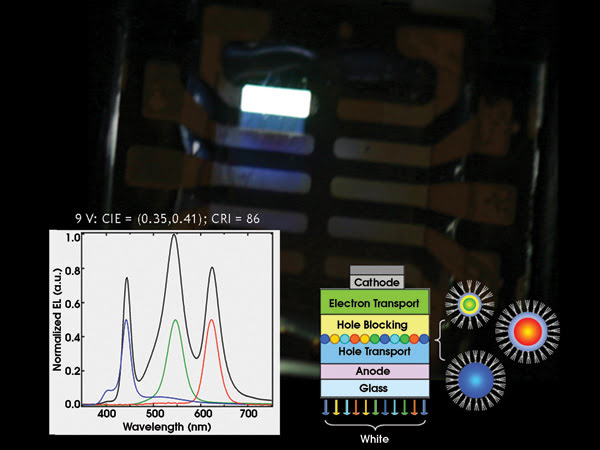
Tuning LEDs Is Like Mixing Paints
Hank Hogan
To get the right light for displays and other devices, you need the proper mix of red, green and blue. Now a team from MIT in Cambridge, Mass., has demonstrated that the same idea can be applied when making LEDs using quantum dots. By using the right ratio, the researchers made a white LED with a color rendering index of 86, a reading about halfway between that of a cool white fluorescent light and that of an incandescent bulb.

Researchers have made a white light LED by mixing quantum dots of three colors together. On top is an image of the white LED, with a schematic of the construction on the lower right. The correct ratio of red, green and blue quantum dots produces the white output, with a high color rendering index. Courtesy of Vladimir Bulovic, MIT.
Quantum dots are nanostructures that, because of their size, emit a very narrow bandwidth of light when excited. The center of that emission depends on the size of the particle, with larger quantum dots emitting at longer wavelengths than smaller ones. Although narrow sources are useful, some applications demand broad sources that can be tuned to a desired output. In part to meet this need, the researchers set out to develop efficient emitters that were mixable and that could be used in an integrated optoelectronic device.
They purchased red quantum dots from Invitrogen Corp. of Carlsbad, Calif. These consisted of a CdS core and ZnS shell and had a photoluminescent peak at 622 nm. For green, they synthesized quantum dots with a ZnS core, a CdS shell and a ZnS alloy overcoat. These particles had a photoluminescent maximum around 540 nm. Finally, for the blue, they fabricated CdZnS alloy quantum dots with a photoluminescent peak of 440 nm.
The device, which they built on the transparent conductor indium tin oxide, consisted of hole-injecting and -transport layers that were topped by a monolayer of emissive quantum dots. Above that, they placed a hole-blocking layer that acted to confine excitation to near or at the quantum dots, and an electron-transporting layer and a cathode of magnesium silver alloy.
The scientists used a 1:2:10 ratio of red to green to blue particles in the device. The skewing toward the blue resulted partly from the relative photoluminescence efficiencies of the various quantum dots. Another factor was that energy transfer between the particles redshifted the overall emission, making it necessary to increase the number of blue emitters.
When voltage was applied, the resulting LEDs appeared white to the eye. Their color rendering index of 86 compares favorably with other sources, such as InGaN/GaN solid-state LEDs. Such devices also have a color rendering index of >80.
Vladimir Bulovic, an associate professor of electrical engineering and computer science, noted that the luminescence efficiencies of these quantum dot LEDs are currently too low for white light applications. “This technology does, however, fulfill the need for a spectrally shaped light source composed of relatively narrow emission lines, as needed for a number of emerging display and imaging technologies.”
He also noted that, by changing the ratio of red, green and blue quantum dots, various spectral outputs could be engineered. Such flexibility benefits both general lighting and other uses. “It enables us to have a spectral source for multiple other applications that involve light, such as imaging, light tagging and lithography.”
Nano Letters, August 2007, pp. 2196-2200
Published: September 2007